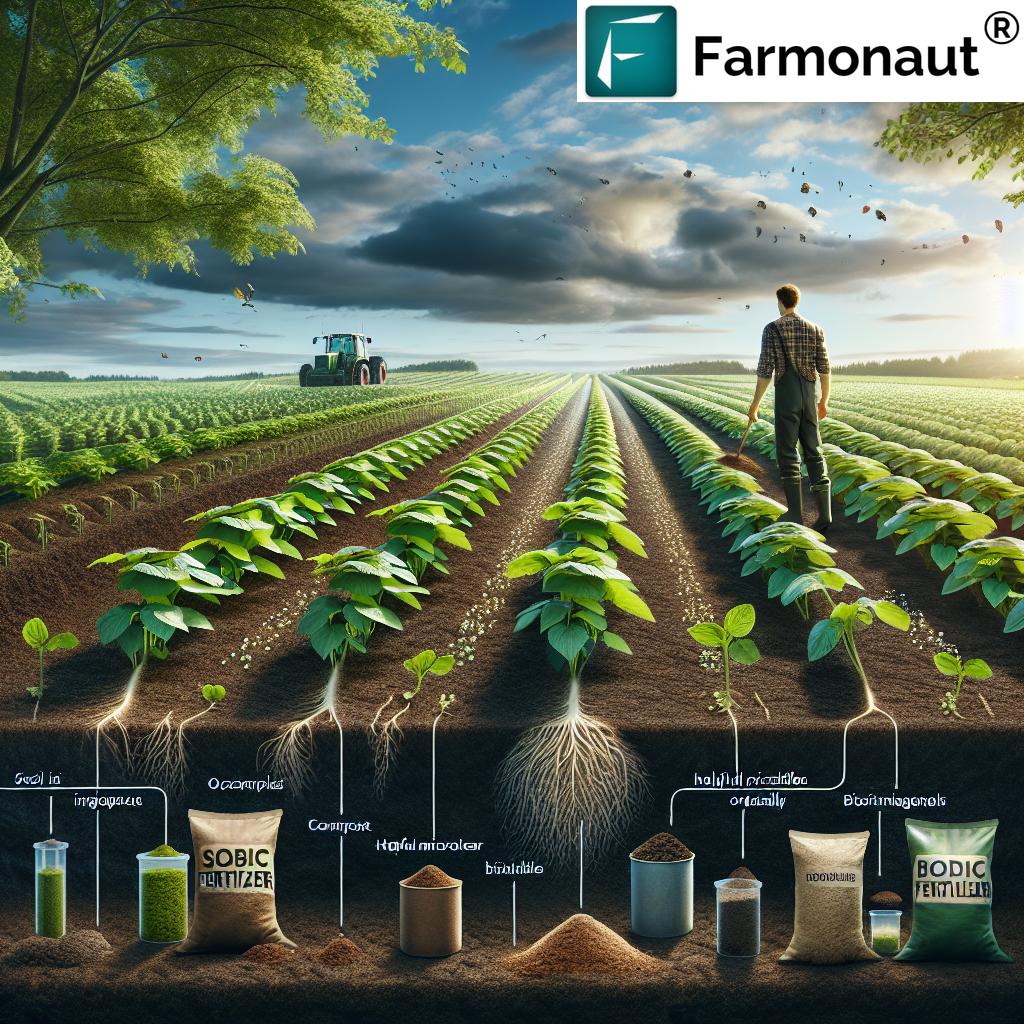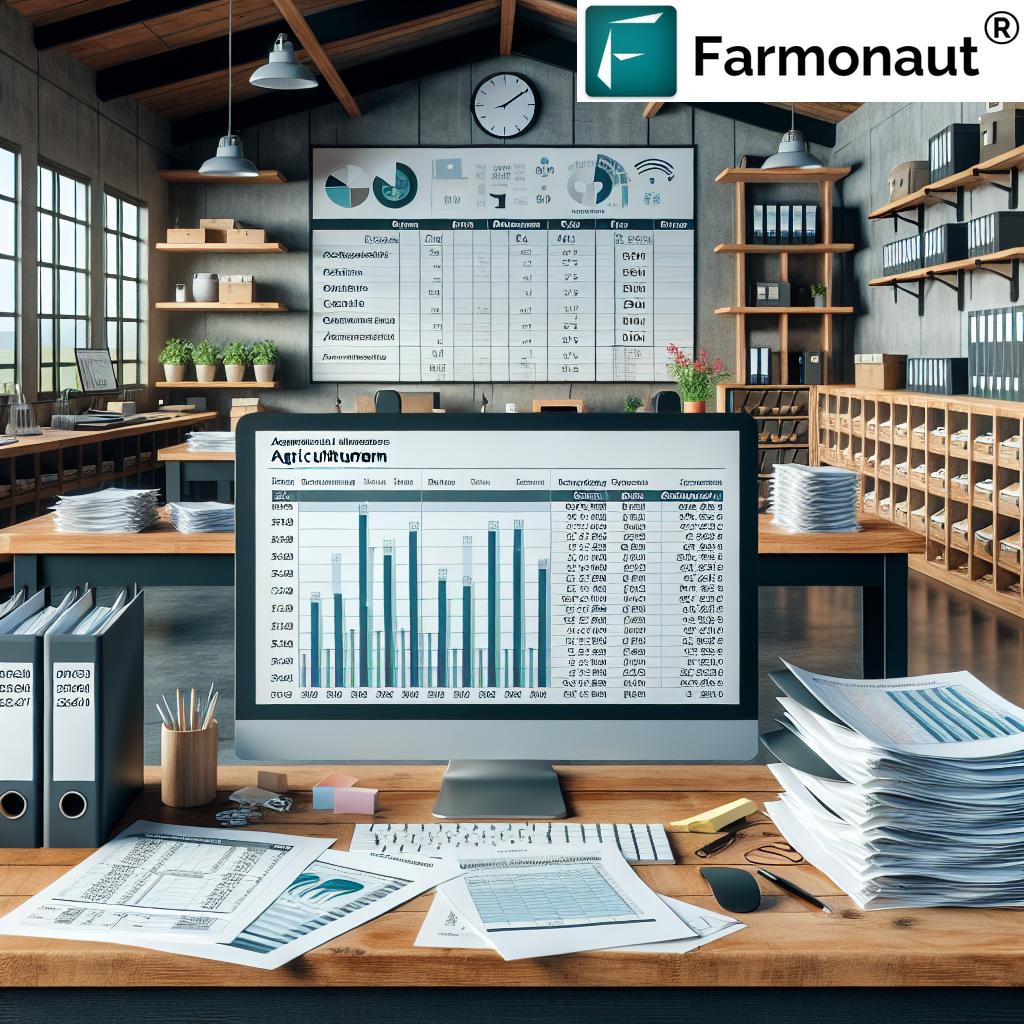Broad-Based Agriculture Investment: Rural & Land Growth (2025)
“Global agriculture investment is projected to reach $1.2 trillion by 2025, with 40% targeting rural infrastructure and land development.”
Table of Contents
- Introduction: The Rise of Broad-Based Agriculture Investment
- What Is Broad-Based Agriculture Investment?
- Key Global Trends in Agriculture Investment 2025
- Key Drivers: Land Growth and Rural Infrastructure
- Sustainability & Environmental Stewardship in Agricultural Investment
- Investment in Farming: Technology, Data, and Innovation
- Investment in Agricultural Land: Value, Returns, and ESG Focus
- Rural Agriculture Investment: Infrastructure, Energy, and Community Growth
- Agriculture Investment Management in a Digital Age
- Comparative Investment Impact Table 2025
- How Farmonaut Brings Precision and Accessibility to Agricultural Investment
- Investment Challenges and Opportunities in Agriculture, 2025
- Key Trends & Opportunities Shaping Future Prospects
- Frequently Asked Questions (FAQ)
- Conclusion: Building Sustainable Growth Across Rural & Land Systems
Introduction: The Rise of Broad-Based Agriculture Investment
As global demand for food intensifies alongside climate change, land degradation, and population growth, the importance of broad-based agriculture investment has reached unprecedented levels in 2025. Strategic allocation of capital across farming, agricultural land, technology, and rural infrastructure has emerged as a pivotal driver for sustainable development, economic growth, and food security globally. This comprehensive article explores the evolving landscape of agriculture investment management, sustainability trends, and innovation, providing insights into how these forces are shaping both rural communities and the broader agricultural sector.
In the sections below, we will delve into the multiple facets of investment in farming, investment in agricultural land, rural infrastructure, and the data-driven strategies transforming agriculture in 2025. We’ll highlight critical trends and answer key questions, ensuring both seasoned investors and those new to the sector gain valuable perspectives.



What Is Broad-Based Agriculture Investment?
Broad-based agriculture investment refers to a diversified capital allocation model where resources are distributed across multiple components of the agricultural value chain. This includes primary production (farming), processing, technology adoption, land acquisition, irrigation infrastructure, supply chains, and rural community support.
- Integrated Model: Unlike niche investing that targets a single facet—such as crop production or farm equipment—broad-based investment approaches integrate capital flows to support everything from input supplies to high-tech agri-innovations. The result is stronger resilience, higher productivity, and stable returns for investors and farmers alike.
- Sustainability Focus: In 2025, the sustainability and social impact of investments are as critical as the potential financial returns. ESG (Environmental, Social, Governance) considerations are now embedded throughout the investment process, driving change and stewardship across the sector.
Why is Broad-Based Agriculture Investment Vital in 2025?
Several global forces are pushing for this integrated model:
- Population and Food Demand – By 2025, global population growth and rising middle-class incomes are putting additional strain on food systems, intensifying demand across all agricultural commodities.
- Climate Change Adaptation – Extreme weather, resource depletion, and changing crop zones demand new investment in resilient agriculture practices.
- Technology Adoption – Satellite imagery, AI, data analytics, and blockchain have revolutionized how farmers and investors approach productivity, risk, and sustainability.
- Social Equity – Investments increasingly seek to empower smallholder farmers and rural communities, ensuring the benefits of agricultural growth are widely shared.
Key Global Trends in Agriculture Investment 2025
In 2025, broad-based agriculture investment is shaped by transformative global trends that influence farming, land, and rural economic systems:
- Digitalization and Precision Agriculture: The rapid digitalization of farm management through AI, IoT sensors, satellite imagery (such as those used by Farmonaut), and big data analytics is making farming more profitable and sustainable.
- Impact Investing: Investors are targeting projects that deliver measurable social and environmental benefits alongside financial returns.
- Land as a Strategic Asset: Investment in agricultural land continues to attract institutional capital seeking stability, inflation hedging, and sustainable returns.
- Sustainable Rural Infrastructure: Financing of irrigation systems, cold chains, and rural logistics is on the rise to cut post-harvest losses and build resilient value chains.
- Financial Innovation: New vehicles—including green bonds, blended finance, and blockchain-based supply chain solutions—are unlocking capital and improving transparency.
Key Drivers: Land Growth and Rural Infrastructure
- Land Growth: Agricultural land remains a sought-after investment asset in 2025, valued for both its productive capacity and its role as a carbon sink. Investment in agricultural land is being reshaped by ESG metrics, regenerative farming, and biodiversity-focused land management strategies.
- Rural Infrastructure: Investment in rural infrastructure (such as roads, bridges, storage facilities, and digital connectivity) is critical to unleashing the economic potential of farming communities. Rural logistics and renewable energy (such as solar irrigation) further enhance supply efficiency, reduce losses, and provide new sources of income.
“Sustainable agriculture initiatives are expected to account for 55% of new rural investment strategies in 2025.”
Sustainability & Environmental Stewardship in Agricultural Investment
Sustainable agriculture investment now sits at the heart of global food security strategies and capital flows:
- Investors increasingly demand proof of sustainability, resource conservation, and environmental stewardship from farm operations.
- Carbon Footprint Tracking is now a central metric for investment, as tracking and reducing emissions align with both regulatory expectations and market preferences. Modern tools, including carbon footprinting solutions, can provide real-time impact data, driving compliance and corporate responsibility in rural agriculture investment.
- Resource Efficiency: Water conservation, regenerative soil practices, and biodiversity-friendly investments are prioritized for their long-term benefits and ecosystem health.
- Socio-Economic Impact: Inclusive, broad-based investment also strengthens rural livelihoods by fostering jobs, skills, and market access for smallholders and local communities.
Investment in Farming: Technology, Data, and Innovation
Investment in farming practices has rapidly evolved, moving beyond traditional input financing toward an integrated, tech-enabled approach:
- Adoption of Precision Agriculture: Through real-time monitoring (like NDVI satellite imagery), climate-smart inputs, and yield optimization, investors can back precisely managed, resilient farms that outpace their peers.
- Empowering Smallholder Farmers: New investments are often coupled with support services, farmer cooperatives, and advisory solutions that help small-scale producers increase their yields and contribute to local food security.
- Pest & Risk Management: Integrating satellite, IoT, and AI-based advisories (such as those provided by Farmonaut’s Jeevn AI) helps farmers detect pests, weather events, and other risks, reducing crop loss and ensuring stable returns.
- Traceability & Transparency: Blockchain-based systems are enhancing transparency, which helps investors, food processors, and end consumers verify claims around sustainability, input usage, and crop origin. Solutions like product traceability make this process seamless.
Investment in Agricultural Land: Value, Returns, and ESG Focus
Farmland acquisition and development has turned increasingly strategic:
- Stable Asset with Long-Term Value: In a volatile financial market, land is a stable inflation hedge and offers the productive capacity needed for food and renewable energy supply.
- Environmental Benefits: Well-managed farmland supports carbon sequestration, biodiversity, and healthy ecosystems. New models prioritize regenerative agriculture—a factor for ESG-conscious investors.
- Due Diligence & Technology: Modern land cover classification and satellite-based monitoring platforms allow better land valuation and risk management. Investors and agribusinesses leverage these insights to optimize acquisition targets and maximize ROI while ensuring environmental compliance.
Rural Agriculture Investment: Infrastructure, Energy, and Community Growth
Rural agriculture investment is central to achieving balanced growth across the food value chain:
- Infrastructure Financing: Roads, storage facilities, and market access points reduce post-harvest losses and open up new trade opportunities for local farmers. Investments in cold chains and rural water management systems also cut waste and enable higher-value crop production.
- Renewable Energy: Off-grid solar-powered irrigation and electrification projects help farmers reduce costs, improve productivity, and build climate resilience. Learn how large-scale farm management tools facilitate this transformation by integrating infrastructure monitoring and planning.
- Social and Economic Diversification: Capital flowing into rural areas stimulates not only farming, but also startups in food processing, logistics, and sustainability consulting, creating diversified local economies.
Agriculture Investment Management in a Digital Age
Agriculture investment management has become highly data-driven and tech-enabled:
- Satellite and AI Monitoring: Asset managers use real-time imagery, machine learning, and historical trend analysis to assess, monitor, and project land and crop values.
- Blockchain & Transparency: Blockchain ensures transparency in supply chains—drivers of trust for institutional investors and consumers alike. Farmonaut’s traceability technology, for instance, enables full product journey verification, supporting compliance with global food regulations.
- Innovative Financing Products: Satellite-based crop verification fast-tracks agricultural loans and insurance, reducing fraud and increasing financial inclusion for farmers, lenders, and insurers.
- Blended Finance & Impact Investing: By combining public and private funds, significant capital is mobilized to support both commercially viable and socially impactful projects, particularly in underserved rural areas.
- APIs & Integrations: Developers and agribusinesses can extend digital capabilities via specialized APIs and tap detailed developer docs for seamless integration across platforms.
Comparative Investment Impact Table 2025
| Investment Area | Estimated 2025 Growth Rate (%) | Environmental Impact | Sustainability Score (1–10) | Potential ROI Estimate (%) |
|---|---|---|---|---|
| Land Acquisition and Development | 5–7 | Medium | 7 | 6–10 |
| Rural Infrastructure (Roads, Storage, Cold Chain) | 8–10 | Low | 8 | 8–12 |
| Sustainable Agriculture Initiatives | 12–15 | Low | 9 | 8–14 |
| Advanced Agri-Tech & Digital Solutions | 15–18 | Low | 10 | 10–15 |
| Renewable Energy for Farms | 10–12 | Low | 9 | 9–13 |
The table above summarizes how different facets of broad-based agriculture investment compare in terms of projected growth, environmental and social benefits, and estimated returns in 2025.
How Farmonaut Brings Precision and Accessibility to Agricultural Investment
At Farmonaut, we focus on making precision agriculture affordable and accessible to farmers, agribusinesses, and governments worldwide through cutting-edge technology. Our satellite-based crop health monitoring and Jeevn AI advisory system empower users with real-time data for informed decision-making. Here’s how our platform aligns with investment in farming and sustainable agricultural growth:
- Satellite Crop Health & NDVI Monitoring: Our app delivers actionable insights, enabling prompt resource allocation and boosting farm productivity while minimizing input costs.
- Carbon Footprinting: We provide carbon tracking tools for agribusinesses to measure, reduce, and comply with global environmental norms—a critical factor in ESG-focused investment in agricultural land.
- Blockchain-based Traceability: Through our robust traceability solutions, investors and corporates ensure transparency, which is key to sustaining consumer trust and opening new premium markets for sustainbly-produced food.
- Fleet and Resource Management: Our fleet management tools help improve operational efficiency for agribusinesses, optimize field logistics, and reduce emissions.
- Accessible via API and Apps: Whether you’re a solo farmer, a large agribusiness, or a developer, you can harness our API suite, with full details in our developer docs, to integrate these insights in your business model.
- Financing & Verification: Our satellite-based verification platform streamlines crop loans and insurance, reducing fraud and making agri-financing more accessible for both financial institutions and farmers.



Investment Challenges and Opportunities in Agriculture, 2025
Despite remarkable advances in technology, management, and capital flow, challenges persist:
- Land Tenure Insecurity: Unclear or disputed land rights in many emerging and rural regions remain a deterrent for long-term investment.
- Regulatory Complexity: Cross-border investments, ecological zoning, and changing legal frameworks require robust compliance monitoring and due diligence.
- Climate Uncertainty: Extreme weather events—drought, flood, pest outbreaks—necessitate climate-smart, adaptive investments in infrastructure and technology.
- Social Inequity: Ensuring fair access for smallholders and indigenous communities is crucial; inclusive investment frameworks are increasingly demanded by regulators, NGOs, and consumers alike.
- Resource Constraints: Water scarcity and soil degradation necessitate sustainable input and output management.
Opportunities arise when these challenges are addressed via:
- Transparent land management frameworks;
- Robust due diligence powered by satellite and AI (for risk assessment);
- Digital platforms for real-time field data, finance, and traceability;
- Training and capacity building for farmers and agri-investors;
- Adapting to evolving consumer trends around sustainably-produced food—now a powerful driver of both premium market access and policy support.
Key Trends & Opportunities Shaping Future Prospects
Broad-based agriculture investment and rural growth in 2025 and beyond will be shaped by:
- Regenerative Land Management: Financing models rewarding land restoration, soil carbon sequestration, and biodiversity enhancement.
- Farmland as Climate Solution: Land remains a strategic asset for institutional investors. ESG-optimized portfolios increasingly favor properties managed with a dual focus on yield and ecosystem services.
- Digital & AI-driven Farm Management: Satellite and AI-powered insights—for instance, via the Farmonaut app—are essential for evidence-based investment and maximizing both ROI and impact.
- Blended Finance Vehicles: New funds blend private, public, and philanthropic capital to unlock larger, scalable agricultural projects in developing regions.
- Supply Chain Innovation: Blockchain, e-marketplaces, and traceability drive efficiency, transparency, and market access for agribusinesses and rural farmers alike.
- Sustainable Input Technologies: Water-saving irrigation, pest and disease forecasting (as enabled in Farmonaut’s advisory system), and climate-resilient seeds will command growing shares of investment in farming capital.
The convergence of these trends will drive the sector toward systems that are not only more productive and profitable, but also sustainable, resilient, and socially inclusive.
Frequently Asked Questions (FAQ)
-
What is broad-based agriculture investment?
Broad-based agriculture investment refers to diversified allocation of capital across the entire agricultural value chain, including land, technology, processing, infrastructure, and sustainability initiatives, rather than focusing solely on one niche, such as crop production or farm equipment. -
Why is rural infrastructure critical for agriculture investment in 2025?
Investment in rural infrastructure—such as roads, irrigation, cold chains, and renewable energy—boosts productivity, reduces post-harvest losses, and enhances economic development in rural communities, providing strong returns for investors and food security for the region. -
How does sustainability affect agriculture investment decisions in 2025?
Sustainability is central. Investors require ESG compliance, carbon footprint tracking, and resource-efficient practices to ensure both financial returns and resilience in the face of climate and regulatory pressures. -
What role does technology play in investment in farming?
Technology—including AI, satellite imagery, and blockchain—enables real-time monitoring of crop health, transparent supply chains, and efficient resource allocation, dramatically increasing yields and reducing risks. -
How is land acquisition evolving for investors?
Farmland remains a coveted asset for institutional and private investors. ESG-compliance, regenerative approaches, and real-time land quality data have become standard requirements for acquisitions. -
How can Farmonaut support investment in agriculture?
At Farmonaut, we provide affordable precision ag solutions, real-time crop health monitoring, AI-powered advisory, supply chain traceability, carbon footprint tracking, and satellite-verifiable data for financial products, supporting efficient, transparent, and sustainable investment in agriculture. -
Where can I learn more about Farmonaut’s products?
Explore our solutions for carbon footprinting, product traceability, crop loan and insurance, and fleet management. For developers, use our API suite and developer docs.
Conclusion: Building Sustainable Growth Across Rural & Land Systems
The future of broad-based agriculture investment is integrated, sustainable, and technology-driven. As we approach 2025 and beyond, deploying capital across farming practices, rural infrastructure, and agricultural land shapes not only our food supply systems but also the resilience and prosperity of rural communities worldwide.
Effective agriculture investment management now demands transparency, environmental stewardship, digital innovation, and a focus on social inclusion. By empowering farmers, agribusinesses, and local communities with real-time data, precision tools, and financing access (as enabled by Farmonaut), we are better positioned to achieve food security, economic growth, and ecological balance on a global scale.
The opportunities and challenges in agricultural investment are significant—but so too are the rewards. Harnessing innovation, fostering inclusive rural growth, and building robust, climate-friendly systems will drive the sector forward, ensuring both economic returns and a healthier planet for generations to come.



Ready to participate in the future of sustainable agriculture investment? Explore Farmonaut’s suite of tools for real-time monitoring, traceability, carbon footprinting, and more, accessible across app, web, and API—empowering you to make smarter, more responsible investment decisions in 2025 and beyond.









